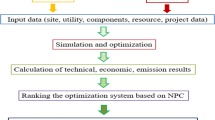Abstract
This paper presents an approach for equipping a cement plant with a wind power plant, a battery storage and an optimized control in order to reduce electricity supply cost and carbon dioxide (CO2) emissions as cement manufacturing is a traditional energy-intensive industrial process, that accounts for around 5% of global CO2 emissions. Therefore, a hybrid simulation model of a cement plant with an integrated optimized control algorithm, a wind turbine model including 24-h forecasts, and market access to the German day-ahead electricity market and the FRR market was built up. The results show, that applying only an optimized control of the cement plant without offering its flexibilities and renewable power supply in combination with a battery storage only causes a slight benefit. Adding flexibility and marketing to the model provides significant cost savings. Adding renewable energy sources and a battery storage to the cement plant can cause a further significant decrease of electricity supply cost per produced ton cement under certain conditions. Regarding the CO2 emissions, installing a wind turbine has an decreasing impact, depending on the location.














Similar content being viewed by others
References
Bazan P, Luchscheider P, German R (2015) Rapid modeling and simulation of hybrid energy networks. In: Proceedings of the 2015 SmartER Europe conference. E-world energy & water, Essen
Deutscher Wetterdienst: http://www.dwd.de. Accessed 21 Oct 2016
ENTSO-E (2014) Network code on electricity balancing. Final draft, Brussels
European Power Exchange: http://www.epexspot.com. Accessed 21 Oct 2016
Fabozzi D, Thornhill NF, Pal BC (2013) Frequency restoration reserve control scheme with participation of industrial loads. In: PowerTech, 2013. IEEE, Grenoble, pp 1–6
GAMS: http://gams.com. Accessed 21 Oct 2016
GUROBI: http://gurobi.com. Accessed 21 Oct 2016
Internetplattform zur Vergabe von Regelleistung (2016) Regelleistung.net. http://www.regelleistung.net
Landgraf M (2009) Grüner zement. Online press information. http://www.kit.edu/kit/pi_2009_610.php. Accessed 21 Oct 2016
lp_solve. http://sourceforge.net/projects/lpsolve/. Accessed 21 Oct 2016
Madlool N, Saidur R, Hossain M, Rahim N (2011) A critical review on energy use and savings in the cement industries. Renew Sustain Energy Rev 15(4):2042–2060
Mitra S, Grossmann IE, Pinto JM, Arora N (2012) Optimal production planning under time-sensitive electricity prices for continuous power-intensive processes. Comput Chem Eng 38:171–184
Schneider M, Romer M, Tschudin M, Bolio H (2011) Sustainable cement production—present and future. Cement Concrete Res 41(7):642–650
Sucic B, Al-Mansour F, Pusnik M, Vuk T (2016) Context sensitive production planning and energy management approach in energy intensive industries. Energy 108:63–73. doi:10.1016/j.energy.2015.10.129
Swanepoel J (2013) Modelling for integrated energy optimisation in cement production. In: 2013 Proceedings of the 10th industrial and commercial use of energy conference (ICUE), pp 1–6. IEEE, New York
Swanepoel JA, Mathews EH, Vosloo J, Liebenberg L (2014) Integrated energy optimisation for the cement industry: a case study perspective. Energy Convers Manag 78:765–775
thyssenkrupp Industrial Solutions AG (2016) Cement industry—sustainable, cost-effectiveffective overall solutions. http://www.thyssenkrupp-industrial-solutions.com. Accessed 21 Oct 2016
thyssenkrupp AG: http://www.thyssenkrupp.com. Accessed 21 Oct 2016
Venter GS (2008) A new DSM simulation model for South African cement plants/GS venter. Ph.D. thesis, North-West University
Acknowledgments
D. Steber and P. Bazan are also a members of “Energy Campus Nürnberg”, Fürther Str. 250, 90429 Nürnberg, Germany. Their research was performed as part of the “Energy Campus Nürnberg” and supported by funding through the “Aufbruch Bayern (Bavaria on the move)” initiative of the Bavarian state. The thyssenkrupp AG and its Corporate Function Technology, Innovation and Sustainability together with thyssenkrupp Resource Technology and thyssenkrupp TechCenter Control Technology provided support to the preparation of the use case and the system configuration as well as the project execution.
Author information
Authors and Affiliations
Corresponding author
Rights and permissions
About this article
Cite this article
Bazan, P., Steber, D. & German, R. Hybrid simulation and energy market based optimization of cement plants. Comput Sci Res Dev 32, 65–77 (2017). https://doi.org/10.1007/s00450-016-0305-8
Published:
Issue Date:
DOI: https://doi.org/10.1007/s00450-016-0305-8




